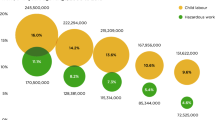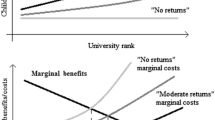Abstract
This paper evaluates the effect of a free compulsory education reform in rural China on the incidence of child labor. We exploit the cross-province variation in the rollout of the reform and apply a difference-in-differences strategy to identify the causal effects of the reform. We find that exposure to free compulsory education significantly reduces the incidence of child labor for boys, but has no significant effect on the likelihood of child labor for girls. Specifically, one additional semester of free compulsory education decreases the incidence of child labor for boys by 8.3 percentage points. Moreover, the negative effect of the reform on the likelihood of child labor is stronger for boys from households with lower socioeconomic status. Finally, the free compulsory education reform may induce parents to reallocate resources towards boys within a household and thus may enlarge the gender gap in human capital investment.


Similar content being viewed by others
Notes
Since the implementation of Compulsory Schooling Law in 1986, the enrollment rates of primary and junior high school has increased remarkably. In 2005, the gross enrollment rate of primary and junior high school was 95%. However, although the short-term impact of the school subsidy program on school enrollment is small, Xiao et al. (2017) show that the program has larger long-term effects on individuals’ educational attainment and cognitive achievement in early adulthood.
He (2016), Tang et al. (2018), and Zhao et al. (2016) are among the few which explicitly analyze child labor in China. He (2016) shows a significant negative effect of child labor on a child’s academic achievement and concludes that child labor is not a big problem in China. However, Tang et al. (2018) find that child labor is not a negligible social phenomenon in China: about 7.74% of children ages 10–15 were working in 2010. Zhao et al. (2016) demonstrate that China’s accession to the World Trade Organization significantly increased the incidence of child labor in rural China.
Maplecroft’s 2014 Child Labor Index evaluates the frequency and severity of reported child labor incidents in 197 countries. China ranks 20th in child labor risks among 197 countries.
In general, the minimum age of employment is 15 years old, which is the minimum age of completion of compulsory schooling (ILO, 1973).
As a robustness check, we also construct the expected number of semesters that a child is supposed to be exposed to the free compulsory education during ages 6–15 and estimate the treatment effects on child labor incidence. The results, which are available from the authors upon request, do not change much.
There are two alternative measures of reform exposure: the actual number of semesters that an individual is exposed to the free compulsory education at the time of the survey and the number of semesters that an individual is supposed to be exposed to the free compulsory education. The actual reform exposure depends on the actual enrollment age, which may be endogenous, so we use the supposed reform exposure instead.
Birth cohort is constructed based on school academic year. For example, children born between September 1997 and August 1998 are supposed to enroll in primary school in the same year and are defined in the same birth cohort.
The relatively large coefficient on semester is mainly driven by the older boys from western China in which the incidence of child labor for 15-year old boys is up to 23.3% in 2010, and the detailed results are available upon request.
The TEOS reform exempted 34 million rural students from paying tuition and miscellaneous fees in 2005 (The Central People’s Government of the People’s Republic of China, 2006), accounting for approximately 20% of 6–15-year-old rural children.
Household net assets include assets in kind and financial assets, net of debt.
References
Basu K, Van PH (1998) The economics of child labor. Am Econ Rev 88(3):412–427
Behrman J, Parker S, Todd P (2010) Do conditional cash transfers for schooling generate lasting benefits? A five year follow-up of PROGRESA/Oportunidades. J Hum Resour 46(1):93–122
Bertrand M, Duflo E, Mullainathan S (2004) How much should we trust differences-in-differences estimates? Q J Econ 119(1):249–275
Bourguignon F, Ferreira FHG, Leite PG (2003) Conditional cash transfers, schooling, and child labor: micro-simulating Brazil’s Bolsa Escola Program. World Bank Econ Rev 17(2):229–254
Cardoso E, de Souza APF (2009) The impact of cash transfers on child labor and school enrollment in Brazil. In: Orazem PF, Sedlacek G, Tzannatos Z (eds) Child labor and education in Latin America. Palgrave Macmillan, New York
Chen Y, Jin GZ (2012) Does health insurance coverage lead to better health and educational outcomes? Evidence from rural China. J Health Econ 31(1):1–14
Chyi H, Zhou B (2014) The effects of tuition reforms on school enrollment in rural China. Econ Educ Rev 38:104–123
Dammert AC (2009) Heterogeneous impacts of conditional cash transfers: evidence from Nicaragua. Econ Dev Cult Chang 58(1):53–83
de Hoop J, Rosati F (2014) Cash transfers and child labor. World Bank Res Obs 29(2):202–234
de Janvry A, Finan F, Sadoulet E, Vakis R (2006) Can conditional cash transfer programs serve as safety nets in keeping children at school and from working when exposed to shocks? J Dev Econ 79(2):349–373
Duflo E (2000) Child health and household resources in South Africa: evidence from the old age pension program. Am Econ Rev 90(2):393–398
Duflo E (2001) Schooling and labor market consequences of school construction in Indonesia: evidence from an unusual policy experiment. Am Econ Rev 91(4):795–813
Edmonds E (2005) Does child labor decline with improving economic status? J Hum Resour 40(1):77–99
Edmonds EV (2008) Child labor. In: Schultz TP, Strauss J (eds) Handbook of development economics, vol 4. Elsevier Science, Amsterdam
Edmonds EV, Schady N (2012) Poverty alleviation and child labor. Am Econ J Econ Pol 4(4):100–124
Ferreira FHG, Filmer D, Schady N (2017) Own and sibling effects of conditional cash transfer programs: theory and evidence from Cambodia1. In: Bandyopadhyay S (ed) Research on economic inequality, vol 25. Emerald Publishing Limited, pp 259–298
Fiszbein A, Schady N (2009) Conditional cash transfers: reducing present and future poverty. World Bank, Washington, DC
Galiani S, McEwan PJ (2013) The heterogeneous impact of conditional cash transfers. J Public Econ 103:85–96
Gunnarsson V, Orazem P, Sanchez M (2006) Child labor and school achievement in Latin America. World Bank Econ Rev 20(1):31–54
He H (2016) Child labour and academic achievement: evidence from Gansu Province in China. China Econ Rev 38:130–150
Heady C (2003) The effect of child labor on learning achievement. World Dev 31(2):385–398
International Labour Organization (ILO) (1973) C138 minimum age convention, 1973. ILO, Geneva
Kassouf A, McKee M, Mossialos E (2001) Early entrance to the job market and its effects on adult health. J Health Policy Plann 16(1):21–28
Liu K (2016) Insuring against health shocks: health insurance and household choices. J Health Econ 46:16–32
Lu F, Anderson M (2015) Peer effects in microenvironments: the benefits of homogeneous classroom groups. J Labor Econ 33(1):91–122
Manacorda M (2006) Child labor and the labor supply of other household members, evidence from 1920 America. Am Econ Rev 96(5):1788–1801
Mu C (ed) (2002) Educational statistics yearbook of China. People's education press, Beijing
National Bureau of Statistics of China (2005) China statistical year book. China Statistical Press, Beijing Available at http://data.stats.gov.cn/easyquery.htm?cn=E0103
National Bureau of Statistics of China (2006) China statistical year book. China Statistical Press, Beijing
O’Donnell O, Doorslaer E, Rosati F (2005) Health effects of child work: evidence from rural Vietnam. J Popul Econ 18(3):437–467
Parker D (1997) Health effects of child labour. Lancet 350:1395–1396
Ravallion M, Wodon Q (2000) Does child labor displace schooling? Evidence on behavioral responses to an enrollment subsidy. Econ J 110(462):C158–C175
Ray R (2003) The determinants of child labour and child schooling in Ghana. J Afr Econ 11(4):561–590
Rosenbaum PR (2007) Interference between units in randomized experiments. J Am Stat Assoc 102(477):191–200
Schady N, Araujo M (2006) Cash transfers, conditions, school enrollment, and child work: evidence from a randomized experiment in Ecuador. Working paper no. 3930. Policy research. The World Bank, Washington, DC
Schultz TW (2004) School subsidies for the poor: evaluating the Mexican Progresa poverty program. J Dev Econ 74(1):199–250
Shi X (2012) Does an intra-household flypaper effect exist? Evidence from the educational fee reduction reform in rural China. J Dev Econ 99(2):459–473
Shi X (2016) The impact of educational fee reduction reform on school enrollment in rural China. J Dev Stud 52(12):1791–1809
Skoufias E, Parker S, Behrman J, Pessino C (2001) Conditional cash transfers and their impact on child work and schooling: evidence from the PROGRESA program in Mexica. Economia 2(1):45–96
Strauss J, Thomas D (1995) Human resources: empirical modeling of household and family decisions. In: Behrman J, Srinivasan TN (eds) Handbook of development economics, vol 3A. North-Holland, Amsterdam, pp 1883–2023
Tang C, Zhao L, Zhao Z (2018) Child labor in China. China Econ Rev 51:149–166
The Central People’s Government of the People’s Republic of China, 2006. Available at http://www.gov.cn/jrzg/2006-04/25/content_265438.htm
Xiao Y, Li L, Zhao L (2017) Education on the cheap: the long-run effects of a free compulsory education reform in rural China. J Comp Econ 45(3):544–562
Xie H (ed) (2011) Educational statistics yearbook of China. People's education press, Beijing
Xie Y (2012) China family panel studies. 2010. User’s manual. Institute of Social Science Survey: Peking University, Beijing
Zhao L, Wang F, Zhao Z (2016) Trade liberalization and child labor in China, IZA DP No. 10295
Acknowledgements
We would like to thank the editor, Junsen Zhang, for his guidance and thank the helpful comments from three anonymous referees, Eric V. Edmonds, Klaus Zimmermann, and conference participants in the 9th International Symposium on Human Capital and Labor Markets and a seminar at IESR, Jinan University. We thank the Institute of Social Survey at Peking University for providing the China Family Panel Study used in this paper. All views and the remaining errors are the authors’ alone.
Funding
This study was supported by the Humanities and Social Sciences Foundation of the Ministry of Education of China (Grant No. 19YJC790193).
Author information
Authors and Affiliations
Corresponding author
Ethics declarations
Conflict of interest
The authors declare that they have no conflict of interest.
Additional information
Responsible editor: Junsen Zhang
Publisher’s note
Springer Nature remains neutral with regard to jurisdictional claims in published maps and institutional affiliations.
Appendix
Appendix
Rights and permissions
About this article
Cite this article
Tang, C., Zhao, L. & Zhao, Z. Does free education help combat child labor? The effect of a free compulsory education reform in rural China. J Popul Econ 33, 601–631 (2020). https://doi.org/10.1007/s00148-019-00741-w
Received:
Accepted:
Published:
Issue Date:
DOI: https://doi.org/10.1007/s00148-019-00741-w




